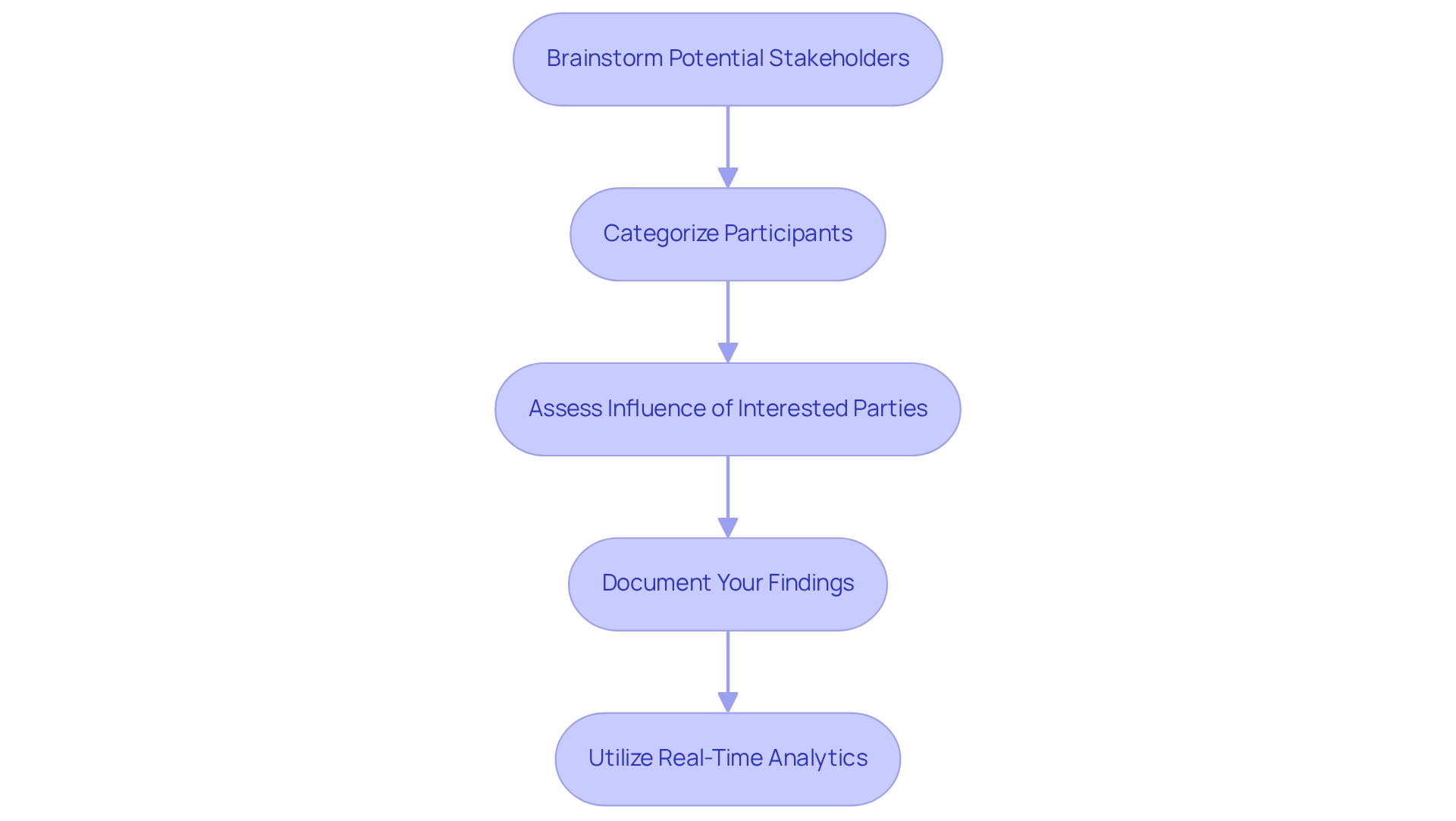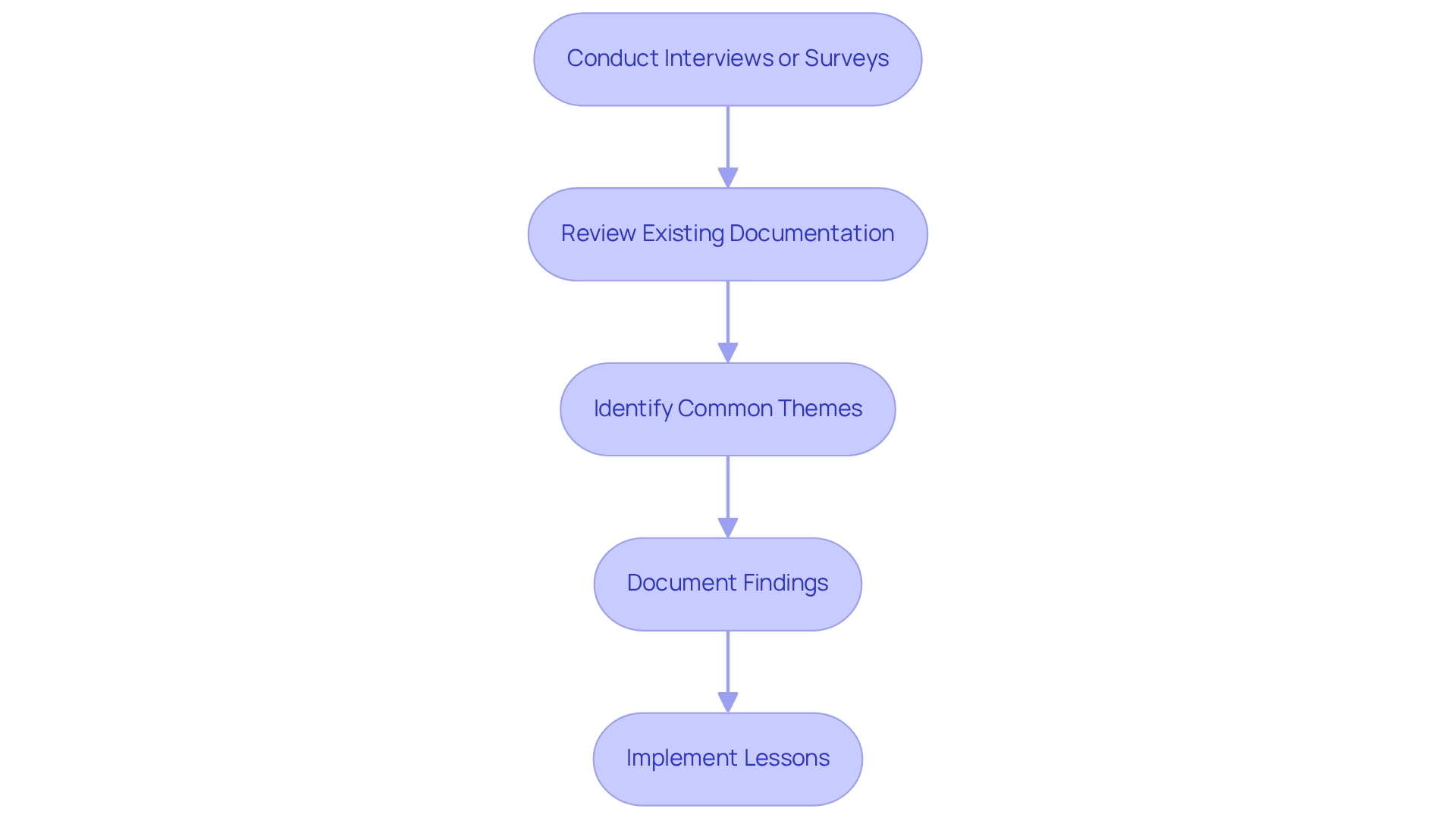Overview
This article presents five essential steps for conducting effective stakeholder analysis in strategic management:
- Identify key stakeholders
- Prioritize them using a Power-Interest Matrix
- Analyze their needs
- Develop tailored engagement strategies
These steps are crucial as they enable organizations to align interests, manage risks, and foster collaboration. Ultimately, this approach enhances project success and ensures sustainable growth. By following these steps, organizations can effectively navigate the complexities of stakeholder relationships and drive their strategic initiatives forward.
Introduction
In a world where organizational success hinges on collaboration and communication, understanding the intricate web of stakeholder relationships has never been more critical. Stakeholder analysis serves as a cornerstone for aligning interests, managing risks, and optimizing resource allocation, ultimately paving the way for sustainable growth. As organizations navigate complex projects and crises, the ability to identify, assess, and prioritize stakeholders becomes paramount. This article delves into the essential steps for conducting effective stakeholder analysis—from identifying key players to developing tailored engagement strategies—ensuring that every voice is heard and every concern addressed in the pursuit of success.
Define Stakeholder Analysis and Its Importance
Stakeholder analysis strategic management represents a systematic process of identifying and evaluating the influence and interests of individuals or groups that can impact or are impacted by a project or entity. This analysis is vital for several reasons:
- Alignment of Interests: It ensures that the objectives of the entity correspond with the interests of its participants, which is essential for project success.
- Risk Management: By understanding the views of involved parties, organizations can anticipate potential conflicts and mitigate risks effectively.
- Resource Allocation: It assists in prioritizing engagement efforts with interested parties, ensuring that resources are distributed effectively to those who are most important.
- Enhanced Communication: A clear understanding of interested parties facilitates better communication strategies, fostering trust and collaboration.
In the context of crisis management, effective analysis of those involved can be the difference between recovery and failure. By starting with a thorough business assessment and collaborating to pinpoint fundamental business challenges, companies can align important participants and gain deeper insight into their business circumstances beyond the figures. This approach not only streamlines decision-making but also operationalizes lessons learned from the turnaround process, reinforcing strengths and building strong, lasting relationships. Consequently, stakeholder analysis strategic management becomes a crucial practice for any entity striving for sustainable growth.
Identify Key Stakeholders in Your Organization
To recognize important participants in your entity, follow these steps:
-
Brainstorm Potential Stakeholders: Assemble a team and identify all individuals or groups that have an interest in your entity. This can include employees, customers, suppliers, investors, and community members.
-
Categorize Participants: Group individuals based on their connection to the entity (internal vs. external) and their degree of influence.
-
Assess Influence of Interested Parties: Evaluate how much power each interested party has to affect your organization’s outcomes. Consider their resources, authority, and connections.
-
Document Your Findings: Create a map or list of interested parties that includes the names, roles, and influence levels of each individual. This will serve as a reference for further analysis.
-
Utilize Real-Time Analytics: Implement a client dashboard to continuously track participant involvement and organizational wellness. This enables prompt modifications in your strategies based on live data, guaranteeing that your stakeholder analysis strategic management is both adaptable and efficient. By systematically identifying interested parties and utilizing real-time analytics, you establish the foundation for successful engagement strategies that facilitate a quicker decision-making cycle, ultimately safeguarding your business during the turnaround process.

Prioritize Stakeholders Using the Power-Interest Matrix
To effectively prioritize stakeholders, utilize the Power-Interest Matrix:
- Draw the Matrix: Create a two-axis grid where the X-axis represents the level of interest and the Y-axis represents the level of power.
- Plot Participants: Position each identified participant on the matrix according to their evaluated power and interest levels.
- High Power, High Interest: Engage closely and manage actively.
- High Power, Low Interest: Keep satisfied but not overly engaged.
- Low Power, High Interest: Keep informed and engaged as needed.
- Low Power, Low Interest: Monitor with minimal effort.
- Analyze the Matrix: Review the positioning of participants to determine where to focus your engagement efforts. This visual depiction aids in clarifying which parties need more attention and resources, and utilizing stakeholder analysis strategic management enables organizations to strategically manage relationships with interested parties, ensuring that those with the most influence are prioritized.
Analyze Stakeholder Needs and Expectations
To examine the needs and expectations of interested parties, follow these essential steps:
-
Conduct Interviews or Surveys: Engage directly with participants through interviews or surveys to gather insights about their needs, concerns, and expectations. This preliminary involvement is crucial for aligning key participants and understanding the context beyond mere figures.
-
Review Existing Documentation: Analyze any existing reports, feedback, or communication that may provide insights into the viewpoints of involved parties. This review can help identify underlying business issues that may need to be addressed.
-
Identify Common Themes: Look for patterns or common themes in the feedback received. This will assist in understanding the broader requirements of your interested parties and inform strategic planning to address weaknesses and strengthen advantages.
-
Document Findings: Create a summary of interested parties' needs and expectations, categorizing them by priority and relevance to your goals. This documentation will serve as a foundation for ongoing business performance tracking and relationship development, utilizing stakeholder analysis strategic management to carefully examine the needs of interested parties. This approach enables organizations to customize their interaction strategies to tackle specific issues, promoting stronger connections and improving project success. Additionally, implementing turnaround lessons through real-time analytics can further enhance effective management of involved parties.

Develop and Implement Stakeholder Engagement Strategies
To develop and implement effective stakeholder engagement strategies, consider the following steps:
- Tailor Communication Plans: Develop personalized communication strategies for each interest group based on their particular needs and expectations. Clearly outline how and when to engage them to ensure relevance and impact.
- Set Engagement Goals: Establish clear objectives for each involved group, such as gaining support, addressing concerns, or providing timely updates. This clarity will direct your involvement efforts.
- Utilize Various Involvement Methods: Employ a diverse range of involvement techniques, including meetings, newsletters, and social media, to effectively reach and connect with stakeholders. This multi-channel strategy improves accessibility and participation.
- Monitor and Adjust: Continuously evaluate the effectiveness of your engagement strategies using the client dashboard for real-time business analytics. Evaluate participant interactions and be ready to adjust based on feedback and changing conditions, ensuring that your approach stays pertinent and efficient.
- Ensure Security: As you interact with your partners, remember that improved encryption and multi-factor authentication will be essential for secure partner platforms. This ensures that sensitive information is protected during communications.
As Reed Bundy, VP of ESG & Employee Experience, emphasizes, "Identifying your key partners is essential for fostering collaboration and enhancing decision-making in your sustainability journey." By implementing these strategies, organizations can leverage stakeholder analysis strategic management to cultivate positive relationships with stakeholders, fostering their support and collaboration throughout the project lifecycle. Additionally, adopting best practices in communication and engagement strategies highlights the importance of proactive communication, clarity, and leveraging analytics tools to track engagement trends.
Conclusion
Understanding and implementing stakeholder analysis is essential for any organization aiming to thrive in today’s interconnected landscape. By clearly defining stakeholder analysis and recognizing its significance, organizations can align their objectives with stakeholder interests, effectively manage risks, allocate resources judiciously, and enhance communication. This foundational practice not only supports project success but also fosters sustainable growth.
Identifying key stakeholders and prioritizing them through tools like the Power-Interest Matrix enables organizations to focus their efforts strategically. Analyzing stakeholder needs and expectations via direct engagement and thorough documentation allows organizations to tailor their strategies to address specific concerns, ultimately strengthening relationships and enhancing project outcomes.
The development and implementation of effective stakeholder engagement strategies further underscore the necessity of proactive communication and adaptability. By employing customized communication plans and utilizing varied engagement methods, organizations can cultivate positive relationships with their stakeholders. Continuous monitoring and adjustments based on real-time analytics ensure that engagement remains relevant and impactful.
In conclusion, stakeholder analysis transcends mere procedural tasks; it is a strategic necessity that empowers organizations to navigate challenges, capitalize on opportunities, and foster collaboration. Embracing these practices will not only enhance decision-making but also solidify the foundation for sustainable success in an ever-evolving environment.
Frequently Asked Questions
What is stakeholder analysis in strategic management?
Stakeholder analysis in strategic management is a systematic process of identifying and evaluating the influence and interests of individuals or groups that can impact or are impacted by a project or entity.
Why is stakeholder analysis important?
Stakeholder analysis is important for several reasons: it aligns the objectives of the entity with the interests of participants, helps in risk management by anticipating conflicts, aids in resource allocation by prioritizing engagement efforts, and enhances communication strategies to foster trust and collaboration.
How does stakeholder analysis contribute to crisis management?
In crisis management, effective stakeholder analysis can be the difference between recovery and failure. It allows companies to align important participants and gain deeper insights into business challenges, streamlining decision-making and operationalizing lessons learned from the turnaround process.
What are the steps to recognize important stakeholders in an entity?
The steps to recognize important stakeholders include: 1. Brainstorming potential stakeholders, 2. Categorizing participants based on their connection and influence, 3. Assessing the influence of interested parties, 4. Documenting findings in a map or list, 5. Utilizing real-time analytics to track participant involvement and organizational wellness.
How can real-time analytics be used in stakeholder analysis?
Real-time analytics can be implemented through a client dashboard to continuously track participant involvement and organizational wellness. This allows for prompt modifications in strategies based on live data, ensuring that stakeholder analysis is adaptable and efficient.
What is the outcome of systematic stakeholder identification and analysis?
Systematic stakeholder identification and analysis establish the foundation for successful engagement strategies that facilitate quicker decision-making, ultimately safeguarding the business during the turnaround process.




